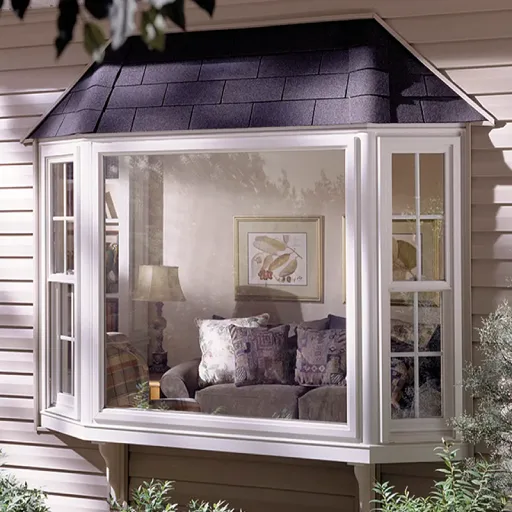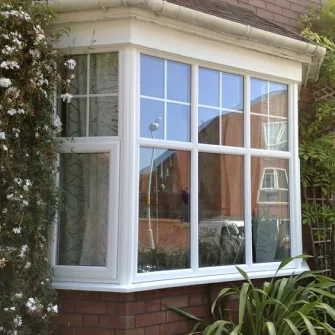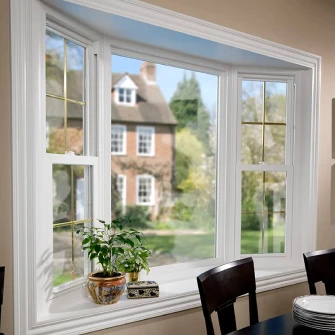Best choose
What Are Bay & Bow Windows?
A bay window typically consists of three window panels joined at specific angles. The center panel (or window) is usually larger than the two side panels, which may be operable windows like casement or double hung. By extending outward beyond your home’s exterior wall, bay windows create a cozy alcove indoors, perfect for seating areas, reading nooks, or decorative displays.
A bow window is composed of four, five, or even six window panels arranged in a graceful, curved arc. This style offers a softer, more rounded look than a bay window. Bow windows often incorporate operable windows among the panels to ensure adequate ventilation. Their fluid, gently arching appearance makes bow windows particularly popular for Victorian-style homes, but they can also suit modern designs when paired with the right materials and finishes.

Extended Floor Space
Creates additional interior real estate, ideal for built-in seating or shelving.
Ample Sunlight
Allows light to enter from multiple angles, brightening interior spaces. Achieves a continuous curved shape for panoramic views.
Multiple Panels
Three panels commonly arranged at 25°, 30°, 45°, or even 90° angles / four or more windows to form an elegant curve.
Benefits of Bay & Bow Windows
- Enhanced Natural Light
Both bay and bow windows let in more sunlight by capturing light from multiple directions. This brightens interiors, cuts down on daytime lighting costs, and helps create an airy, welcoming environment. - Increased Space and Functionality
Because these windows extend past the exterior wall, they enlarge your interior living area. This extra nook can be transformed into a reading corner, breakfast area, or even additional storage with custom cabinetry or seating. - Elevated Curb Appeal
A bay or bow window is an instant attention-grabber. The outward projection, architectural detail, and stylish design elements contribute to a more impressive facade, boosting your home’s overall aesthetic and potentially increasing resale value. - Panoramic Views
Large glass surfaces provide expansive sightlines of your front yard, backyard, or surrounding scenery. If you have a property with beautiful vistas, bay and bow windows can truly showcase them.



Frequently Asked Questions (FAQ)
Are bay and bow windows energy-efficient?
Yes, they can be. Look for Low-E coatings, gas fills (like argon) between panes, and high-quality frames. Proper installation and insulation around the window cavity are also crucial to minimize drafts and heat transfer.
How do I decide between a bay and a bow window for my home?
Consider aesthetic preference, available space, and budget. Bay windows generally have three panels and a more angular shape, while bow windows consist of four or more panels that form a gentle curve. Bow windows typically let in more light but can be more expensive.
Can I install a bay or bow window on any exterior wall?
In principle, yes, but you must ensure the wall can support the additional weight and projection. A professional installer will assess your home’s structure to determine feasibility and recommend any necessary reinforcements.
Do bay and bow windows require special permits?
It depends on local building codes. In some U.S. municipalities, you might need a permit for extensive modifications to your home’s exterior or for structural changes. Check with your local building department or consult a licensed contractor.
How long does it take to install a bay or bow window?
Installation time varies, but it typically ranges from one to three days for a straightforward replacement. More complex projects involving new framing, custom roofing, or major structural work can take longer.
Are there smaller bay or bow window options for compact spaces?
Yes. While many bay and bow windows are large, manufacturers also offer smaller units designed for limited wall space. You can still enjoy the benefits of extra light and a bit of added interior space, but on a more modest scale.
How do I style the interior space created by a bay or bow window?
Many homeowners install built-in seating or banquettes with storage underneath. You can also place potted plants, reading chairs, or decorative accents. Opt for window treatments that fit each panel or a single curved track for bow windows.
Do I need a roof overhang for my bay or bow window?
Typically, yes – especially for bay windows, which often include a small roof element above the projection. This roof not only completes the exterior look but also protects the window from rain and snow.


